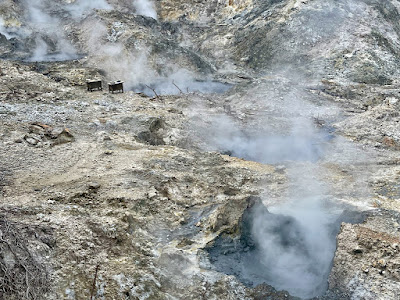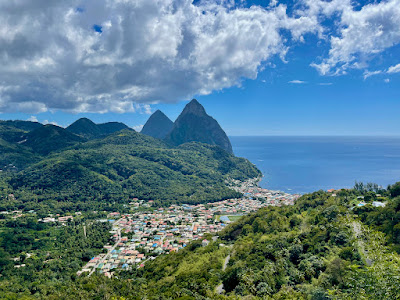 |
| Exotic flora in the Botanical Gardens |
Last night’s Caribbean menu included Baked Banana Wrapped in Bacon with Rum Sauce and a Chilled Pina Colada Soup with Citrus Biscuit. They really were going for it and, on balance, the meal was good - that’s the second in a row! It was topped off with half of a nice bottle of Campo Viejo (the rest tonight, methinks).
However, we both had a fairly restless night’s sleep. Whether it was from the wine or the food, we both woke regularly but still started the day reasonably refreshed. We woke in St Lucia at 6:30am and took a leisurely room service breakfast on our balcony, overlooking Arvia, which is in the harbour with us.
 |
| Arvia on the left and Aurora on the right |
Frankly, I can’t fancy holidaying on a massive ship like that. Just to give context, it has up to 5,200 guests and 1,800 crew against Aurora’s 1,874 guests and 850 crew. I know which one I prefer. Also, Arvia has had some fairly massive problems since its maiden voyage, where all the electronics systems decided they weren’t up to the job.
Aurora is altogether well-seasoned, discreetly elegant and fairly understated. All of which made the unexplained booming country music that echoed around the ship as we queued on the quay for our trip somewhat bizarre. Was this the new Captain putting his mark on how the ship would be run? Had a disaffected crew member broken into the comms room and threatened to play John Denver until someone met his demands? No one knew and we all stood on the quay, looking at each other as some technician deep in the ship decided whether the screeching and distorted music should perhaps be toned down a little? As we left on the catamaran, it had subsided to tolerable levels, but still continued to play - something that’s never happened before.
 |
| Queueing, British-style |
We had formed a human crocodile to the end of the quay and then had a fairly long wait in the sun. For what? We did not know. All we did know was that there were probably 150 people and they were all signed onto the St Lucia by Land and Sea trip. And so we waited in an orderly British fashion, some of us in the shade, others in full sun. Officials paced up and down.
 |
| The catamaran |
Then a catamaran arrived. Would we all get on that? Hopefully not because it would have been crowded. All at once, the queue was divided in two and our half began to file onto the cat. As we were fairly well back, we had little hope of snagging a prime seat but, because so many people can’t do steep steps, we headed onto the top and got two sunbeds next to a couple with whom we’ve chatted quite a lot. The other half waited for minibuses which had not arrived as we left.
The reality was that, because Arvia was also in port with its hordes, there were going to be many people doing the same excursions. Consequently a convoy of catamarans headed out to sea and began to race around the island. Ours was by far the fastest and we sped along the coast and past lush green islands and then, all at once, there was an oil storage facility on its own island. We headed into a pretty inlet where locals were spoiling the photo opportunity by burning wood on the end of a pier.
 |
| Hurricane Hole Hotel |
Opposite this activity was the incredibly attractive and photogenic Hurricane Hole Hotel - oh yes, put this one in your bucket list folks. The surroundings were deeply wooded with expensive villas peeking through the trees to capture the best views. We left that area and travelled around the headland and pulled into a bay where the cat anchored ready for swimming. Guests were warned that the water in between the cat and the beach was wet, which did not seem to put many people off the idea as there was a long queue to get off and swim.
 |
| The hawker, selling his wares |
From a little canoe, a hawker was selling carved coconut shells while he was paddling around the cat. More boats were piling into the tiny bay and the sea was filling with bodies. If you’d gone to that beach for a quiet dip you’d be sorely disappointed.
 |
| And Gabrielle was there too, doing her mermaid impression |
But the water was clear, the fish were friendly and, as we set sail and the complimentary rum punches began to flow, Jason Mraz was playing his easy-on-the-ear tunes over the sound system. All was well with the world and it was quite delightful.
 |
| The Pitons |
Rounding yet another headland we were confronted by the Pitons - two giant volcanic teeth jabbing at the sky. They’re quite jaw-dropping. They stand next to the town of Soufrière, the name of which means sulphur in the air - you’ll find out why in a moment. The area is called the Breadbasket of St Lucia. There are many Rasta men with elaborate dreadlocks loping lazily along the streets. We, meanwhile have disembarked the cat and got into a very hot minibus to go to the Diamond Botanical gardens and waterfall.
 |
| Our temporarily angry guide, Dona |
Once again, we’re suffering from volume of people from Arvia all running on the same tours. The place is crowded and we have a very angry young woman as guide. We don’t yet know the reason for her ire, but she’s shouting at someone behind us as we enter the gardens and her bad mood continues as she snaps out facts and figures about the exquisite plants we are seeing. She’s actually very good and, once she calms down, she becomes a bit more smiley and approachable.
 |
| Vegetables and fruit grown on St Lucia |
The garden has a huge variety of exotic rainforest flowers and trees and our guide shows us the range of vegetables grown and consumed on the island, including yam, sweet potato and varieties of plantain and banana. There are huge apricots, breadnuts which are like chestnuts, cashews, papaya, sugar cane, coconut, turmeric and breadfruit.
 |
| A selection of the flowers and trees from the Botanical Garden |
Throughout the garden there are dazzling displays of the most exotic flowers you can imagine - some well known and others never before seen. It’s a visual treat.
 |
| Waterfall in the Botanical Gardens |
At the top of the gardens is a waterfall which is full of stripes of colour from the minerals that are dissolved in the pale grey water that splashes down its face.
 |
| The beautiful rainforest environment |
In and amongst all this beauty, iridescent humming birds flittered like huge insects - almost impossible to photograph.
 |
| The grey water from the volcanic source |
It’s at this point that we understand why our guide was so angry. Another one of the guides was high as kite - possibly on ganja or alcohol or both. His group was looking on in bewilderment as he babbled incoherently and waved his arms around and upset the guides’ system to keep groups separated. Our guide was later seen earnestly on the phone and the other’s name was frequently mentioned.
We left the garden and the stoned guide and climbed high up into the “drive-in” volcano as they called it. This is a large caldera which was formed in 1766 during a massive eruption that tore the mountain apart. The area of the caldera is around 12 square kilometres and in one area there are steam vents, bubbling cauldrons of superheated mud and an all-pervading smell of hydrogen sulphide. If there is a day when there is no smell, get off the mountain, because it’s a sure sign of of an imminent eruption.
 |
| Gabriel's Hole |
The area around the vents used to be open for the public to wander around and to cook vegetables and meat over the fumaroles, but an accident occurred some years ago where a man called Gabriel jumped on an area of rock and it collapsed, dumping him up to his waist in the boiling 100 degree mud with 170 degree steam. It’s thereafter been called Gabriel’s Hole and he apparently survived and even had children. Now, only geologists are allowed in. There are monitors for tremors and air quality to check whether anything is likely to kick off. This is one of 19 volcanoes in the Caribbean and it formed the whole island through its eruptions. The strange-looking Pitons are also volcanoes but are in fact like a plug that never erupted.
We changed our bus and got air con that worked! This bus driver was really going for it and we sped to our destinations. It was a nerve-wracking drive and we were actually overtaken on a tight bend by a car. Most of the journey took place in second gear, whether we were going up or downhill. The many hairpin bends and sharp turns with vertiginous drops, complemented by bits of abandoned or wrecked vehicles by the roadside, didn’t make us confident.
Huge ferns and palms line the roads in the mountains - it’s like a Lost World style environment all along the periphery of the rainforest. We also learned that St Lucia has 60 inches of rain per annum along the coast and 160 inches in the interior. That’s why it’s so lush.
St Lucia was originally Spanish but it kept exchanging ownership for many years between France and Britain. French influence is still strong, particularly in the language and place names, but they still have our King appointing a governor general. Currently they’re waiting on one so the acting governor general is called Errol Charles. It’s a very colonial place with a lovely feel.
 |
| Looking out over the Pitons and Soufrière |
We headed back to Castries via a couple of viewpoint/tourist traps at one of which I bought the most delicious banana bread. Key ingredients? Nutmeg and cinnamon. As we drove we passed through a huge, 1000 acre banana plantation. Sugar cane was long ago abandoned as a crop and replaced with bananas which is a year round crop. 20% of the UK crop comes from St Lucia and is marketed as Fairtrade. The bananas are bagged on the tree and shipped green; they must be without any blemishes or they will be rejected. It takes around 7-9 months to grow a bunch of bananas. Once the crop is done, the suckers from the tree will sprout 3-5 times to grow baby trees and so the process continues. The St Lucians cook bananas green, with or without skin.
 |
| Gentle rain over Castries |
On our return, we were reminded why the island is so green: gentle rain showers and rainbows greeted our return. What a lovely day.






.jpeg)

.jpeg)
Lovely Photos! Looks very tropical! Bet the sea is a bit warmer than here, it's a struggle even in a wet suit!
ReplyDeleteAmy x
Gabrielle said it was cool but OK. Certainly not UK temps!
DeleteApparently there is a rastaman mountain guide who will take you to top of a St Lucia piton via a secret path CharliePxxxx
ReplyDeleteSome of the passengers did just that - not us, though!
Delete